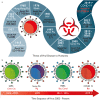Sustainable Personal Protective Clothing for Healthcare Applications: A Review
- PMID: 32866368
- PMCID: PMC7518242
- DOI: 10.1021/acsnano.0c05537
Sustainable Personal Protective Clothing for Healthcare Applications: A Review
Abstract
Personal protective equipment (PPE) is critical to protect healthcare workers (HCWs) from highly infectious diseases such as COVID-19. However, hospitals have been at risk of running out of the safe and effective PPE including personal protective clothing needed to treat patients with COVID-19, due to unprecedented global demand. In addition, there are only limited manufacturing facilities of such clothing available worldwide, due to a lack of available knowledge about relevant technologies, ineffective supply chains, and stringent regulatory requirements. Therefore, there remains a clear unmet need for coordinating the actions and efforts from scientists, engineers, manufacturers, suppliers, and regulatory bodies to develop and produce safe and effective protective clothing using the technologies that are locally available around the world. In this review, we discuss currently used PPE, their quality, and the associated regulatory standards. We survey the current state-of-the-art antimicrobial functional finishes on fabrics to protect the wearer against viruses and bacteria and provide an overview of protective medical fabric manufacturing techniques, their supply chains, and the environmental impacts of current single-use synthetic fiber-based protective clothing. Finally, we discuss future research directions, which include increasing efficiency, safety, and availability of personal protective clothing worldwide without conferring environmental problems.
Keywords: COVID-19; PPE; antimicrobial; antiviral; environmental impact; medical textiles; personal protective equipment; protective clothing; single-use PPE; sustainability.
Conflict of interest statement
The authors declare no competing financial interest.
Figures







References
-
- CDC . Using Personal Protective Equipment (PPE), https://www.cdc.gov/coronavirus/2019-ncov/hcp/using-ppe.html (accessed 2020-04-25).
-
- Ford S.Nurse Poll Hints at Scale of Shortage of Key Masks, Gowns and Respirators. Nursing Times, https://www.nursingtimes.net/author/steve-ford/page/15/?cmd=gotopage&=402 (access 2020-09-03).
-
- Rajendran S.; Anand S. Developments in Medical Textiles. Text. Prog. 2002, 32, 1–42. 10.1080/00405160208688956. - DOI
Publication types
MeSH terms
LinkOut - more resources
Full Text Sources

